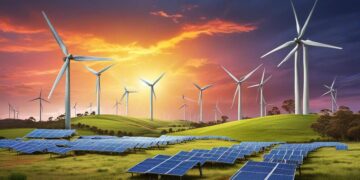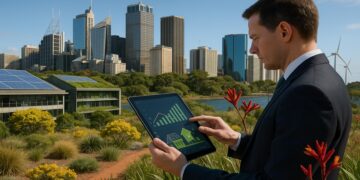Investment Opportunities in Renewable Energy in Australia

A Sustainable Future Awaits
Australia is a land abundant in natural resources, and as the world turns its gaze toward sustainable energy, the opportunities within the renewable energy sector have never been more prominent. With escalating climate concerns and a collective push towards greener solutions, Australia is well-positioned to be a leader in this essential transformation. The nation, with its expansive landscapes and diverse climates, offers a fertile ground for innovative projects that not only promise returns on investment but also resonate with an ethos of environmental responsibility.
Solar Power: Harnessing the Sun
Australia enjoys one of the highest levels of solar radiation worldwide, a pivotal asset in the era of clean energy. Regions like Queensland and New South Wales are witnessing a phenomenal growth in solar farms, driving down the costs of solar energy production. For instance, the world’s largest solar plant, located in Nyngan, showcases how substantial investments in solar energy can yield unmatched returns while promoting sustainability. Investors can capitalize on this trend by targeting residential solar panels, which have seen a significant uptake in suburban areas, aiding households in reducing energy bills and contributing to a more sustainable grid.
Wind Energy: Tapping Coastal Winds
In addition to solar energy, Australia’s coastal regions, particularly in Tasmania and South Australia, present a promising landscape for wind energy generation. The Roaring Forties winds provide consistent and powerful gusts, ideal for harnessing wind energy. The Hornsdale Wind Farm near Jamestown is a prime example of successful wind energy implementation, contributing significantly to South Australia’s energy needs while illustrating the feasibility and effectiveness of large-scale wind power. Investors standing at the helm of this wave can explore opportunities in new wind farms or enhancing existing infrastructure, thereby ensuring a robust and resilient energy future.
Hydro Power: Revitalizing River Systems
With existing hydroelectric infrastructure, Australia can enhance its renewable energy capabilities through improved efficiency and modernization. Major river systems, such as the Murray-Darling Basin, can be harnessed more effectively to produce hydroelectric power. Adapting technology for better water management and energy production can yield significant benefits for local communities and contribute to a sustainable environment. As climate patterns shift, innovative hydro solutions can provide reliable energy while minimizing ecological impact.
Battery Storage: The Future of Energy Security
A key component of the renewable energy landscape is battery storage. As the demand for intermittent renewable sources grows, robust battery systems are essential for storing energy during peak production times for use during high-demand periods. Australia is already taking steps to integrate large-scale battery facilities, with projects like the Tesla Big Battery in South Australia showcasing the potential of this technology. Investors focused on battery storage solutions can find lucrative opportunities in both residential and commercial sectors, catering to a growing demand for energy security and stability.
Government Support and Investment Opportunities
The Australian government is strategically promoting clean energy initiatives, offering various incentives such as grants and tax rebates to encourage investment in the sector. Policies aimed at reducing greenhouse gas emissions and fostering renewable energy technologies create a stable regulatory environment that is conducive to growth. For investors, this means venturing into a market that not only prioritizes sustainability but also offers potential financial advantages.
As global trends increasingly favor sustainable practices, aligning with these shifts presents a dual opportunity: potential financial rewards and contributing to a healthier and more sustainable planet. With Australia leading the charge in renewable energy, the time is ripe for investors and entrepreneurs to explore the myriad possibilities within the renewable energy sector—forever transforming the energy landscape in the Land Down Under.
Exploring the Landscape of Renewable Energy Investments
As Australia embarks on a formidable journey towards renewable energy adoption, the multitude of opportunities extends far beyond initial solar and wind projects. Investors eager to tap into this vibrant sector need to appreciate the unique combination of natural resources, technological advancements, and governmental support that shapes the renewable energy landscape. With a concerted effort to reduce carbon emissions, expand sustainable practices, and innovate energy solutions, Australia stands as a promising terrain for both new and seasoned investors.
The Upsurge of Green Technologies
Australia’s commitment to transitioning to renewable energy sources is not solely confined to solar and wind energy. A myriad of other technologies is emerging, driven by both necessity and ingenuity. For instance, biomass energy—where organic materials are converted into clean energy—presents intriguing potential. Agriculture, forestry, and waste management sectors can play a vital role in biomass production, allowing investors to explore local and sustainable solutions.
- Bioenergy from agricultural waste: Utilizing by-products from farming operations, such as straw and manure, can generate energy while tackling waste management challenges.
- Algal biofuels: With advancements in algal cultivation, there is an opportunity to convert algae into biofuels that could supplement traditional energy sources.
- Waste-to-energy projects: Transforming landfill waste into energy sources not only diverts waste but also creates sustainable energy avenues.
Geothermal Energy: Tapping Into Earth’s Heat
An underutilized asset in Australia’s energy portfolio is geothermal energy. With vast land across the continent, regions such as South Australia and Queensland possess untapped geothermal resources. By harnessing the earth’s natural heat, geothermal systems can offer reliable energy production with minimal environmental impact, presenting promising exposure for investors willing to pioneer this relatively new field in the country. Projects that combine state-of-the-art technology with existing geothermal reservoirs can boost energy independence while contributing significantly to job creation and local economies.
Residential and Commercial Energy Solutions
Beyond large-scale infrastructure, a sizable opportunity lies in the burgeoning market of energy efficiency technologies for both residential and commercial spaces. This includes products that enhance energy conservation, such as smart home systems, energy-efficient appliances, and LED lighting solutions. Smart grid technologies are also gaining traction, enabling better energy management, real-time monitoring, and optimized energy distribution. As consumers become more environmentally conscious, there is increasing demand for innovative energy solutions that reduce their carbon footprint.
Investment in these technologies not only promises financial growth but also aligns with Australia’s vision of a sustainable future. Understanding the interplay of these various facets will undoubtedly inform the next steps for investors seeking impactful and profitable ventures within the renewable energy sector. With foresight and adaptability, there is a wealth of opportunity waiting to be unearthed in Australia’s push towards a sustainable energy market.
Capitalising on the Growth of Hydrogen Energy
One of the most promising frontiers in Australia’s renewable energy landscape is hydrogen energy. Harnessed primarily from renewable resources, hydrogen has emerged as a game-changer in the energy sector. With the nation’s abundant solar and wind resources, Australia is poised to become a global leader in green hydrogen production. This clean fuel has the potential to power industries, transport, and even serve as an export commodity. Investors keen to enter this space will find projects focused on producing hydrogen through electrolysis—using electricity generated from renewables to split water into hydrogen and oxygen—a focal point for both innovation and profitability.
- Export potential: With countries like Japan and South Korea aggressively pursuing hydrogen as a clean energy solution, Australia can capitalize on its geographical advantages and abundant renewable resources to export hydrogen globally.
- Hydrogen fuel cells: Investing in the development and deployment of hydrogen fuel cells for transport applications, including public transport and heavy vehicles, can stimulate both economic and environmental benefits.
- Research and development: Forming partnerships with universities and research institutions to innovate hydrogen technologies can foster new business models and technological advancements.
The Role of Energy Storage Systems
As renewable energy generation often depends on variable factors such as weather and time, energy storage systems become absolutely essential. The Australian energy market is witnessing a transition with the incorporation of advanced battery solutions that address the intermittent nature of renewables. The rise of battery storage technologies, particularly lithium-ion batteries, creates significant investment opportunities that can enhance energy reliability and stability.
Investors can explore:
- Utility-scale battery projects: Partnering with energy companies to develop grid-scale battery storage can help balance supply and demand while optimizing grid performance.
- Residential battery solutions: Offering energy storage systems for residential use is a growing market, as homeowners look for ways to capture power generated by solar panels and reduce energy costs.
- Pumped hydro energy storage: Investing in traditional yet effective pumped hydroelectric systems can provide a long-term storage solution that complements solar and wind energy generation.
Government Incentives and Policy Support
For potential investors, it is crucial to keep abreast of the evolving regulatory framework that promotes renewable energy projects. The Australian government has rolled out multiple incentives and policy measures to accelerate the transition towards a sustainable energy landscape. Initiatives such as the Renewable Energy Target (RET) not only guarantee financial support but also ensure that developers can predictably navigate the renewable energy market. Foreign investment frameworks also provide security and transparency, which are vital for attracting global capital into Australia’s renewable sector.
As environmental policies continue to tighten and community demand for sustainability grows, businesses willing to adapt and innovate within this environment will thrive. The landscape is ripe for investments that not only promise financial returns but also contribute actively to Australia’s ecological goals. Thus, a diverse portfolio that encompasses various renewable energy sources and technologies will position investors favourably in this dynamic market.
Conclusion
As Australia stands on the brink of a renewable energy revolution, the opportunities available for investment are more abundant than ever. With the country’s vast natural resources, including sunlight and wind, the potential for generating clean energy is unprecedented. From solar and wind power to the promising avenues of hydrogen energy and energy storage systems, investors have a diverse range of options at their fingertips that promise not only profitability but also a sustainable future for generations to come.
Strategically, Australia can leverage its strengths in the renewable sector to position itself as an export powerhouse, particularly in hydrogen production—a sector that is poised for significant growth given global trends towards decarbonization. Additionally, as energy storage technology matures, investing in this segment will be crucial for creating a resilient energy grid capable of meeting future demands.
Moreover, the supportive government policies and frameworks help create a transparent environment for investment, providing essential incentives for businesses willing to participate in this transition. Investors who are attentive to the evolving regulatory landscape will undoubtedly find successful ventures amidst this transition to sustainability.
In conclusion, embracing investment opportunities in renewable energy not only aligns with growing environmental imperatives but also opens the door to economic growth and innovation. Australia’s commitment towards a greener future enables stakeholders to contribute to a healthier planet while reaping significant financial rewards. For those ready to engage now, the potential for impact and return is monumental.

James Carter is a financial writer and advisor with expertise in economics, personal finance, and investment strategies. With years of experience helping individuals and businesses make complex financial decisions, James offers practical insight and analysis. His goal is to give readers the knowledge they need to achieve financial success.






